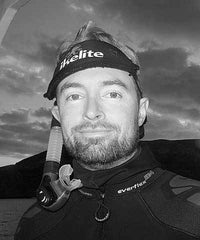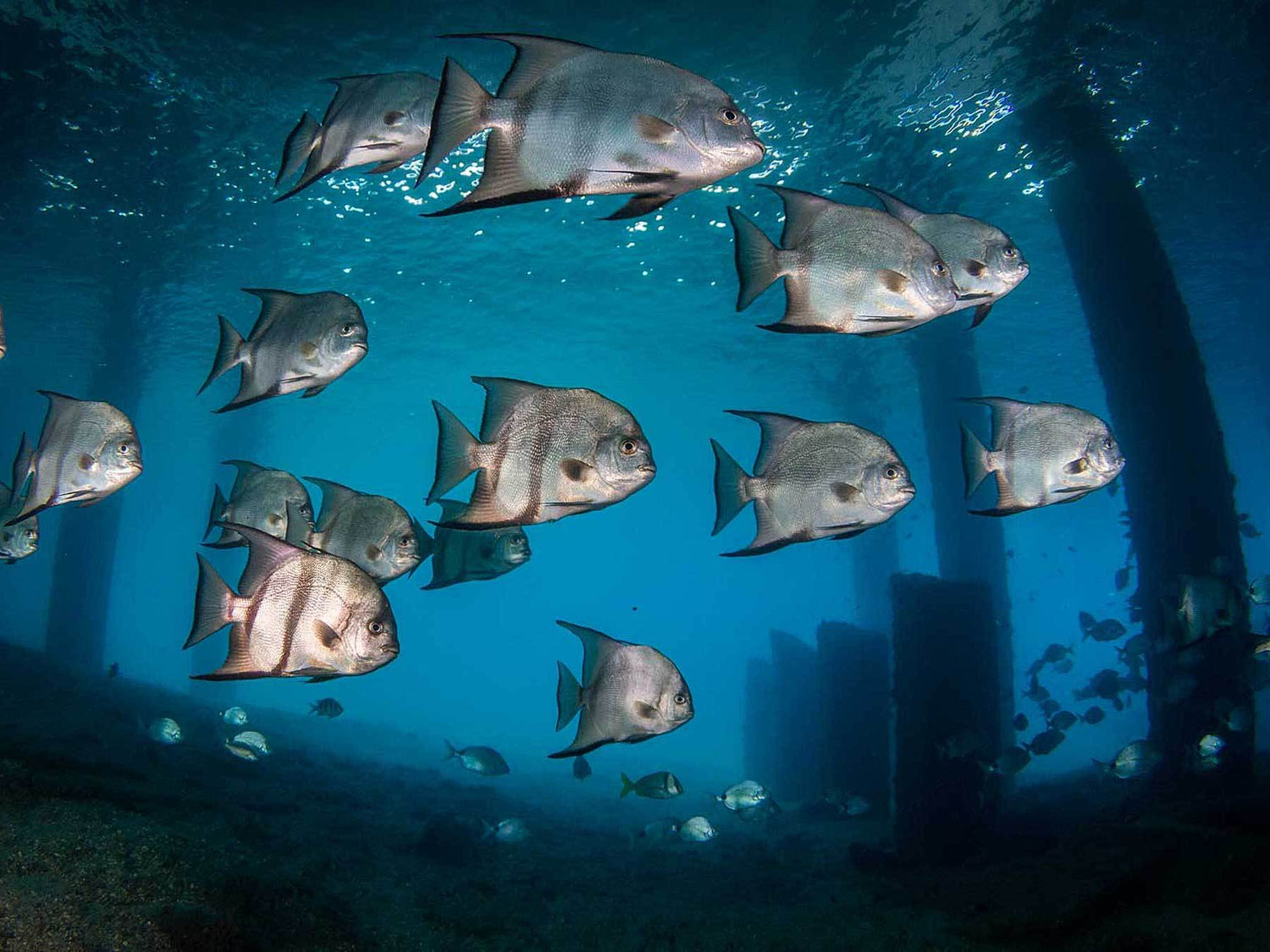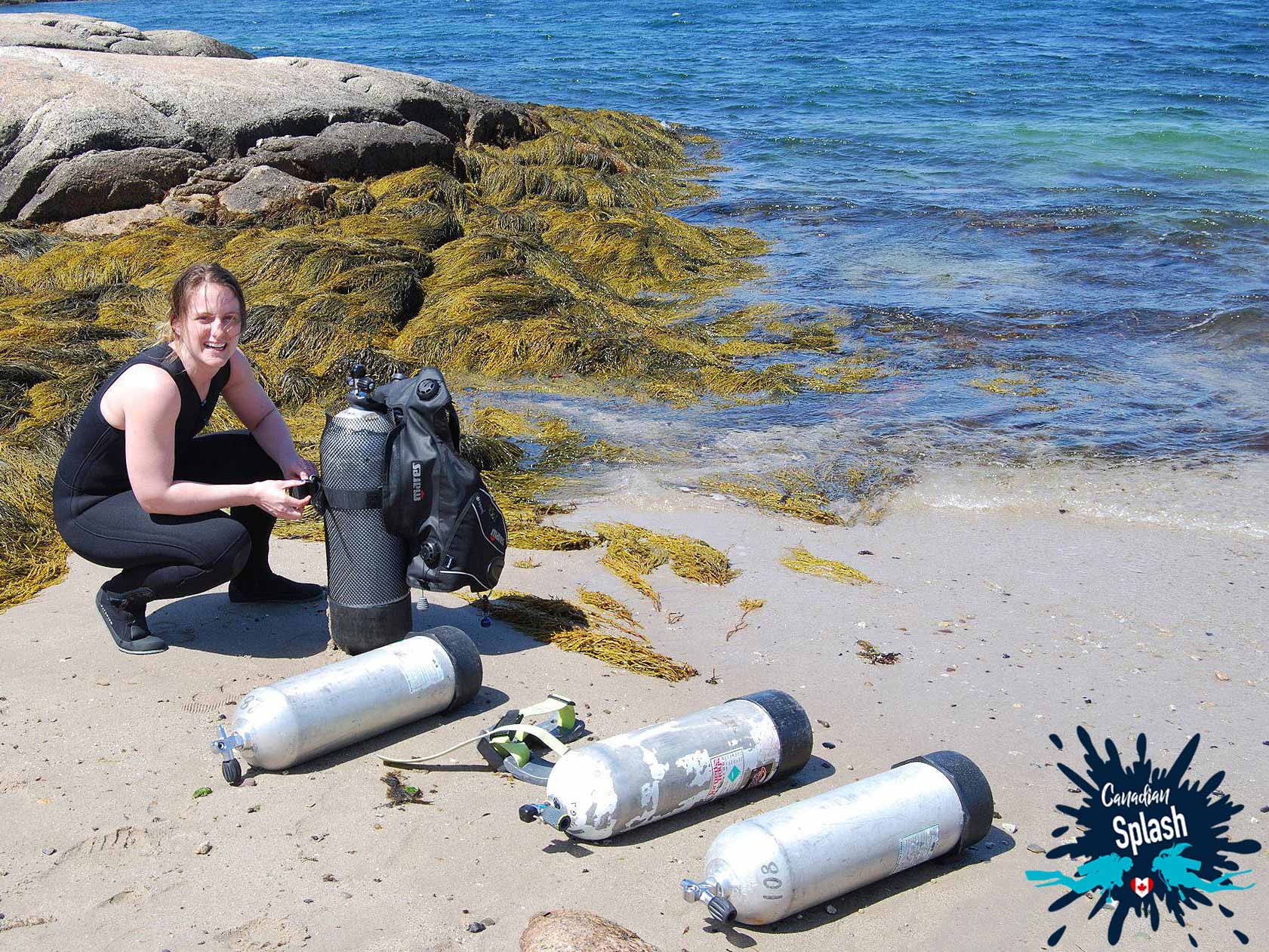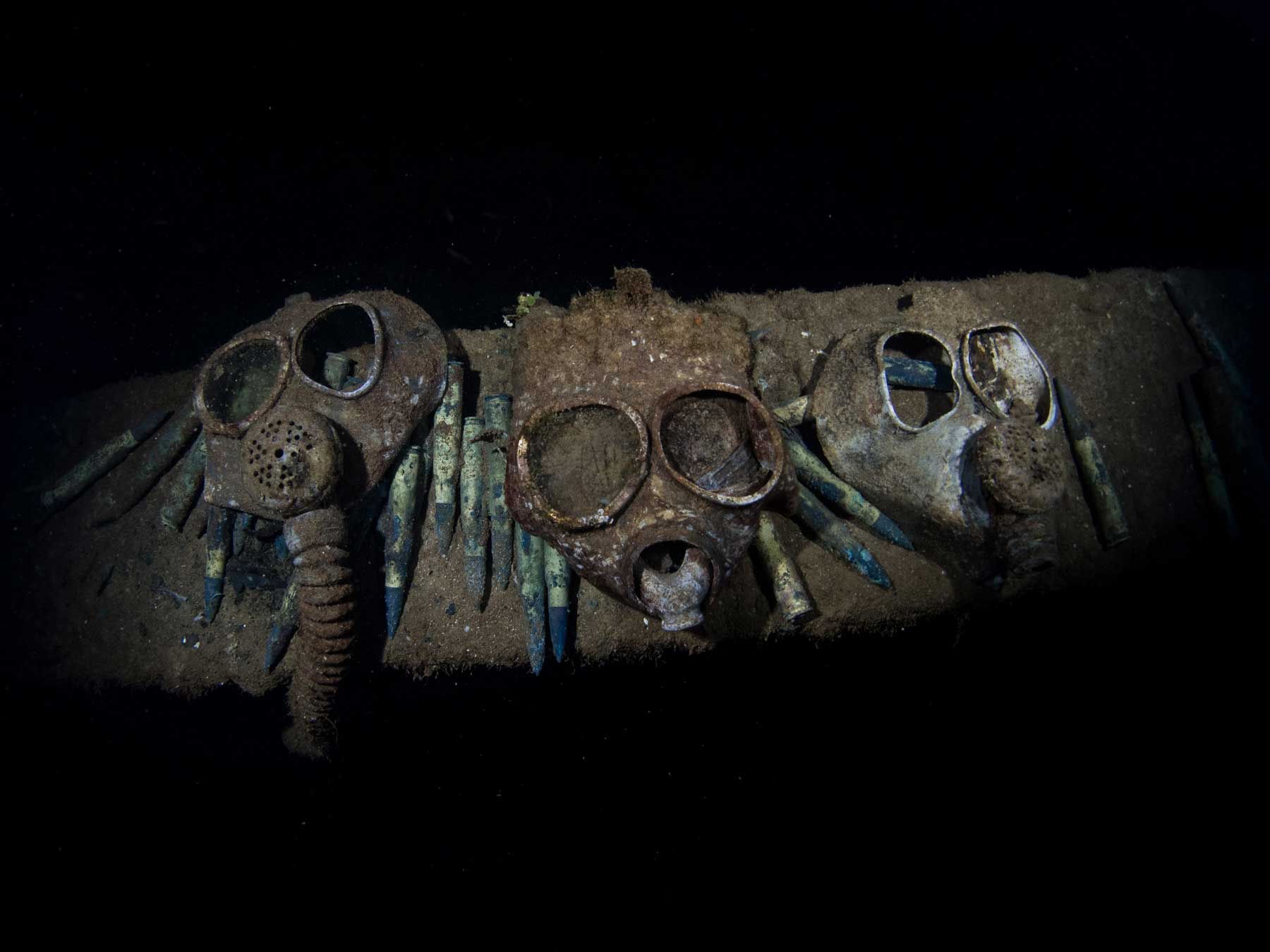By Bryant Turffs
Blue Heron Bridge in Riviera Beach, Florida is a dive site that has something for everyone. I have seen many superlatives attributed to the site over the years and I can assure you that it lives up to the hype. It is a site that is welcoming to divers of all skill levels and it can evolve with your interests.
The bridge appeals to novice divers for its shallow depths (not exceeding 25 feet), its ease of access, and reef-scapes that hold many colorful tropical fishes. It appeals to advanced divers, especially photographers, because of the abundant macro life and the opportunity to see rare species that seem to appear at the bridge with uncommon frequency.

Bumblee shrimp can be found on echinoderms, like this one sheltered on a sea star, and can provide super-macro opportunities.
Although Blue Heron Bridge makes for an easy and enjoyable experience, there are important factors that must be taken into account when planning your dive. The first challenge you may encounter is parking. The dive site is accessed from Phil Foster Park, which serves boaters, beachgoers, and divers alike. On holidays, weekends, and other exceptionally beautiful days, the parking lot fills to capacity. Be sure to arrive early to find a good spot - up to two hours before your dive when the park is at its busiest.

Look for juvenile highhats around debris, sometimes they are no bigger than a fingernail.
Once on site one of the first things a diver will notice about the Blue Heron Bridge dive site is its unusual location. It lies within the Lake Worth Lagoon, part of the Intracoastal Waterway. For this reason, it is important to dive at high tide to ensure good visibility (20-40 feet is great visibility for this site).
Because of the tidal flow, currents must also be taken into account. The best time to dive is generally one hour before and up to one hour after a high tide when current is slowest and clean, clear ocean water has flooded the lagoon. Tide tables can be found online to use in planning your dive.

Spotted Morays lurk in the crevices around structure.
If you are new to diving and/or new to the site, it can be a good idea to hire a guide from one of the many dive shops in the nearby area. A guide can show you the best features of the site and make you aware of safety considerations first hand. They also often know where the best creatures hide allowing you to make the most of your dive and photo opportunities.

The wreck on the east side of the Bridge is a fun landmark and can visited on a dive with the east end of the snorkel trail.
If you choose to dive on your own it's important to keep a few safety matters in mind. Always carry a dive flag and stay within the bounds of the site as boats frequent the surrounding area. Do not descend in the swim area (demarcated by red buoys) or the lifeguards will be mad!
While tides are predictable and currents manageable, the conditions vary from day to day. Visibility can be influenced by rainfall and rough weather offshore. Contact a local dive shop or check out the Blue Heron Bridge Dive Club Facebook page for up to date information on visibility. Also make a visual check before you enter the water. If it looks clear (ideal!) or brown (not ideal!) from shore, it probably is the same underwater too.
Pay attention to the current as you dive. I have experienced unexpected changes and stronger currents than anticipated. The site is bigger than you can explore in one dive, and it is easy to return, so do not wear yourself out swimming further than needed. Pick a small area to explore and if the conditions become uncomfortable, have an exit strategy. Rinse and repeat often for best results.

Three or More Sites in One
The Blue Heron Bridge dive site can be divided in three distinct areas. The first is the sand and the snorkel trail directly off of the beach entry area. Although sand may sound boring at first, I love this area because it is the home to many octopus and also to striated frogfish that hang around the scattered debris.
Have a look around when swimming out to the snorkel trail. The snorkel trail itself (which is equally good for scuba diving and snorkeling) is a long line of rocks, statues, and artificial reefs that lies in about 10 feet of water. This area is great for new divers because it is near the entry area, holds many tropical species like angel and butterfly fish and it is shallow. Keep the swim zone in mind when in this area. You may surface swim through it, but you may not dive within it.

Octopus of two species, the common (pictured) and the Atlantic long arm, are commonly encountered at the bridge.
A second area to explore is the west bridge. This area consists of a sand and rubble bottom 10-15 feet deep and the only structure is the bridge itself. The bridge pilings are home to many fish species including the strange looking scrawled filefish and photogenic Atlantic spadefish. This affords opportunity for wide angle photography.
The rubble bottom below and south of the bridge is also great to explore for macro life. It may appear featureless at first, but do not be fooled and have a closure look. Countless cryptic species hide here. Nudibranchs can be found in the hydroids and associated shell bottom. Photogenic sail fin and pike blennies and even bizarre-looking batfish and seahorses may be found here as well.
Keep in mind that currents can be strong under the bridge when visiting this area. I usually plan to have the incoming tide carry me away from the entry area, for high tide to occur halfway through my dive, and for the outgoing tide to carry me back. Also, avoid the fishing pier to the north of the bridge due to the hazard that fishing lines present.

A scrawled filefish glides before the dappled light of the setting sun during a twilight dive.
The final area is the east bridge. This might be my favorite (though its hard to choose!) because it has a little bit of everything. There is a shell and rubble area below the bridge and to its south, which is great for macro life and varies from 10-20 feet deep. I have found a few species in this area that I have not seen anywhere else including freckled guitarfish and lesser electric rays.
This bridge is lower, which makes it darker underneath (sometimes eerily so), so its worth bringing a light, and it can allow for creative wide angle photography. There are also a couple boat wrecks and some dock pilings on this side that are fun to explore. Currents near this bridge section are similar to those on west side carrying you under the bridge towards the north on an incoming tide and then back South on the outgoing. An added challenge on this side is that the outgoing tide that occurs in front of the beach takes you away from the exit. The current will bring you out from under the bridge and partway back, but I often walk along the beach to the exit area at the end of the dive.

A Lesser Electric Ray glides over debris near dock pilings on the east side of the bridge. This ray is a rare find in Florida and the only place I have seen it in the state is at the bridge.
A Few Last Tips and Notes on Conservation
The above information should get you started with diving at Blue Heron Bridge, but there are a few extra thoughts I will share to ensure the best dive experience for all. The bridge is a beloved dive site and recently an outpouring of popular support from the dive community made it a protected area where collecting fish is prohibited. Its popularity, though, puts it at risk of being over-loved.
We as divers and photographers have an impact too. Please practice good buoyancy habits - especially when carrying a camera - to avoid crushing sensitive marine life. It may be appropriate to touch down in the sand, but look below first. Try to avoid touching down in shell and rubble, because the abundant life here is unavoidable.

Look for nudibranchs like this flabellina on hydroids. If you are used to indo-pacific species you will be surprised at how tiny and cryptic the Florida ones can be!
If you are interested in macro photography, go slow! Finding macro critters is a skill that requires practice, and if you are not finding much, you are probably going too fast. When you do make a find, keep in mind that many small organisms, like seahorses, are sensitive to your presence and the camera’s flash. Try to get your shot efficiently and move on. If you need to practice technique, find something inanimate, achieve your desired effect, then move to live subjects.

Sailfin blennies are a charismatic subject for macro photography. They are found in areas of rubble and you can experiment with lighting to enhance background aesthetics. Keep and eye out if you find one, there are often others nearby.
A hack for finding awesome macro subjects is to watch others. There are many experienced divers at the bridge who find things I would never locate myself. It is important in these instances though, to keep your distance and wait your turn. Nothing is more frustrating than finding that sought after subject and setting up for the shot only to bumped into and crowded out by other divers. On the same note, try to be generous and share when you find something interesting. Do not forget the importance of moving on quickly in these instances when multiple photographers are lined up in order to avoid harassing the marine life.
If you are practicing macro photography, do not forget to look up from time to time too, you never know when a manatee or eagle ray may zoom by!

Batfish - Look for these strange-looking cryptic bottom dwellers in the rubble.
Twilight and night dives are some of my favorite times to visit the bridge. You can encounter all kinds of animals and behaviors not seen during the day. The park technically closes at 10PM and your car should not be there any later.
Local dive shops host free night dives when the tides are right. To ensure a good night dive experience, keep a look out for these events!
Whatever time it is when you exit the water, Phil Foster Park has some nice amenities including outdoor freshwater showers and public restrooms. I hope to see you out at the bridge soon and that you enjoy this wonderful and unique dive site.

Keep an eye out for small critters floating in the water column like this grass squid.
All images copyright © 2020 Bryant Turffs
 Ambassador Bryant Turffs has worked on six of the seven continents as a biologist, boat captain, dive professional, commercial fisherman, photographer, and educator. Today he lives in Palm Beach County, Florida, and works with his partner, Jessica Pate, to understand the mysteries of the local manta ray population. He also uses his photography to tell other natural history and conservation stories. Read more...
Ambassador Bryant Turffs has worked on six of the seven continents as a biologist, boat captain, dive professional, commercial fisherman, photographer, and educator. Today he lives in Palm Beach County, Florida, and works with his partner, Jessica Pate, to understand the mysteries of the local manta ray population. He also uses his photography to tell other natural history and conservation stories. Read more...
Additional Reading
Featured Photographer: Bryant Turffs on Looking Deeper
Planning a Trip to Photograph Manatees in Crystal River, Florida
Cousteau's Aquarium | Sea of Cortez with the Nikon Z6
Planning a Shore Diving Trip to Bonaire
An Insiders Guide to Diving Wakatobi Resort Indonesia













